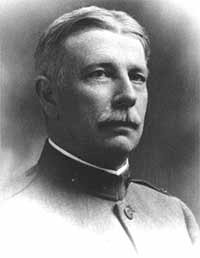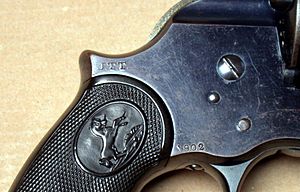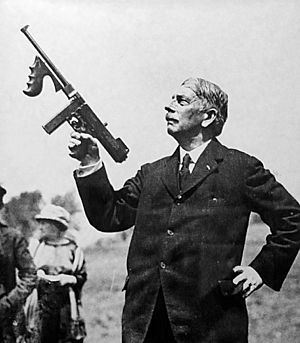John T. Thompson facts for kids
Quick facts for kids
John T. Thompson
|
|
|---|---|

Photograph of Thompson
|
|
| Birth name | John Taliaferro Thompson |
| Born | December 31, 1860 Newport, Kentucky, U.S. |
| Died | June 21, 1940 (aged 79) Great Neck, New York, U.S. |
| Buried |
West Point Cemetery
|
| Allegiance | United States |
| Service/ |
United States Army |
| Years of service | 1882–1914, 1917–1918 |
| Rank | Brigadier General |
| Awards | Distinguished Service Medal |
| Other work | Auto-Ordnance Corporation founder |
John Taliaferro Thompson (born December 31, 1860 – died June 21, 1940) was an officer in the United States Army. He is most famous for inventing the Thompson submachine gun, often called the "Tommy Gun."
Contents
Growing Up and Becoming a Soldier
John Thompson was born on December 31, 1860, in Newport, Kentucky. Because his father, Lieutenant Colonel James Thompson, was in the Army, John grew up living on many different Army bases. By the time he was 16, he knew he wanted to be a soldier too.
He went to Indiana University for a year. In 1877, he was accepted into the United States Military Academy at West Point, New York. This is a special school for training Army officers. He graduated from West Point in 1882.
His first job in the Army was in Newport, Kentucky, where he was a second lieutenant. He then studied engineering and artillery. In 1890, he joined the United States Army Ordnance Corps. This part of the Army deals with weapons and ammunition. Here, he started to focus on small firearms.
Helping in the Spanish–American War
When the Spanish–American War began, Thompson was promoted to lieutenant colonel. He was sent to Tampa, Florida, to manage all the weapons and ammunition for General William R. Shafter's forces in Cuba.
While other parts of the Army had trouble getting supplies, Thompson made sure that over 18,000 tons of ammunition reached the battlefield safely. He did this without any accidents! Because of his excellent work, Thompson was promoted to colonel, becoming the youngest colonel in the Army at that time.
During this war, Thompson also saw how useful automatic weapons could be. He helped set up a special unit with Gatling guns. These guns fired many shots quickly. This unit played an important role in the Battle of San Juan Hill.
After the war, Thompson became the chief of the Small Arms Division. In this role, he helped develop the M1903 Springfield rifle. He also led the board that approved the M1911 Colt pistol, which became a very popular handgun.
Innovations During World War I
When World War I started in Europe in 1914, Thompson felt strongly that the United States should help the Allied countries. Since the U.S. had not yet joined the war, Thompson saw a chance to help and also to make money. He left the Army in November 1914.
He then became the Chief Engineer for the Remington Arms Company. He oversaw the building of the Eddystone Arsenal in Pennsylvania. At the time, this was the largest factory for making small firearms in the world. It made rifles for British and Russian soldiers.
The war introduced new ways of fighting, like trench warfare. By 1916, Thompson began working on new automatic weapons. He wanted to design a weapon that soldiers could use to quickly clear out enemy trenches. He called this idea a "trench broom."
Thompson was very interested in a special gun system invented by John Blish. With Blish as his partner, Thompson found money to start the Auto-Ordnance Company. They began designing the weapon that would become the famous Thompson submachine gun.
When the United States finally joined World War I in April 1917, Thompson returned to the Army. He was promoted to brigadier general. He was in charge of all Army weapons factories during the rest of the war. For his great service, he received the Army Distinguished Service Medal. This award recognized his excellent work in making sure the Army had enough rifles and ammunition.
After the war, in December 1918, he retired again. He then focused on making the "Tommy Gun" perfect.
Thompson first tried to make a special rifle using Blish's system. However, the powerful .30-06 rifle bullet was too strong for this system to work well.
So, Thompson decided to use the .45 caliber ammunition for the Thompson submachine gun. This was the same ammunition he had approved for the M1911 pistol while in the Army. The weapon was patented in 1920. However, the war had ended, so there were not many orders from the military.
Thompson then sold the weapon to police departments and other law enforcement groups. They bought a good number of them. But by 1928, sales were low, and the company faced money problems. Thompson was replaced as the head of the Auto-Ordnance Company.
Family Life
John Thompson married Juliet Estelle Hagans. Their son, Marcellus Hagans Thompson, also graduated from West Point in 1906. He left the Army in 1919 as a captain to work with his father in the automatic weapons business.
Later Life and Legacy
John Thompson passed away on June 21, 1940, at the age of 79. He is buried at the United States Military Academy in West Point, New York.
Soon after his death, the U.S. was preparing to enter World War II. The Army then ordered many Thompson submachine guns. The "Tommy Gun" was used a lot during that war, both in its original form and in newer versions.
See also
- Tommy Gun (book)
 In Spanish: John T.Thompson para niños
In Spanish: John T.Thompson para niños



